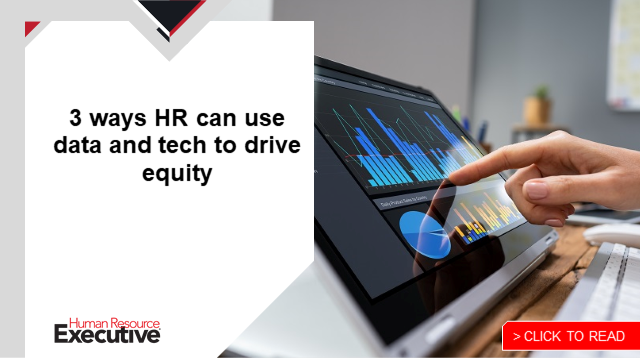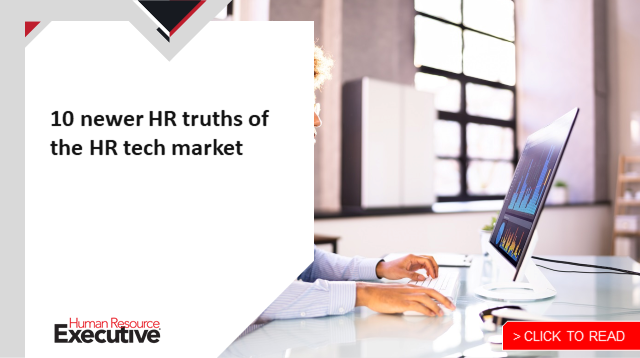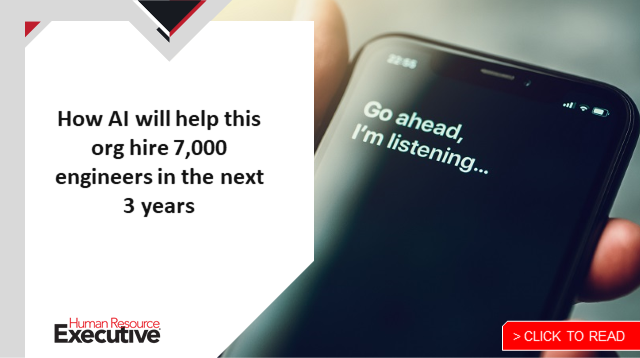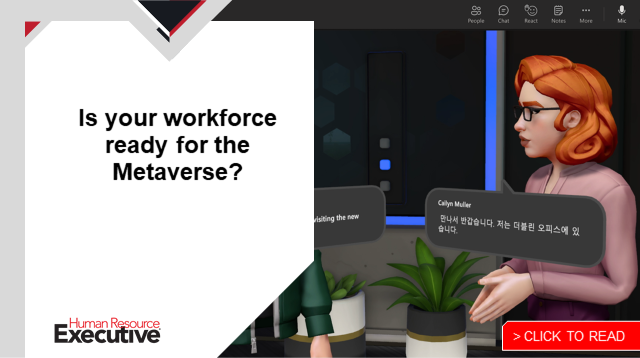It’s a dilemma: HR leaders and the IT teams that support them need data to reverse the Great Resignation, power the internal marketplace, improve the employee experience and identify hotspots where workers are racing to the exits. And while they have collected vast amounts of employee data—from a worker’s recruitment and onboarding details to performance reviews and exit interviews and nearly all events in between—this trove of information can be difficult to find among disparate silos and can be a chore to analyze on a timely basis.
Thanks to modern data analytics software, HR leaders can begin to unearth hidden insights in their operations, more readily allowing them to reverse old thinking and create new HR and managerial practices that keep employees engaged and operations running more smoothly.
Often, this valuable data already resides in the HR department’s systems. HR leaders can find useful information from surveys, listening initiatives and check-ins they conduct, for starters. They can examine employee engagement in town hall meetings, participation in learning and development programs, and examine life events such as adding a new dependent on a health plan, PTO data and the ages when employees retire or resign their position.
Related: Registration for HR Tech 2022 in Las Vegas is now open
The data is out there, waiting to be used, according to Rebecca Wettemann, principal at research firm Valoir. “HR’s been tasked with gathering, managing and analyzing more data in the past two years than ever before,” she says. “However, HR has an opportunity now to think creatively about how non-sensitive data can be gathered and meaningfully analyzed to craft more personalized experiences for employees.”
Here is a look at how three powerhouse firms—Colgate, NCI and Panasonic—improved their operations with data analytics and a commitment to act on what they found.
Retirement rates for Colgate’s Gen Z vs. Baby Boomers
 The Great Resignation has forced every employer to ask the same questions: Why do employees leave, and what makes them stay?
The Great Resignation has forced every employer to ask the same questions: Why do employees leave, and what makes them stay?
In 2021, Colgate-Palmolive adopted a solution from data analytics provider OneModel to build a data warehouse to store and provide access to the HR and people-related information gathered from its 34,000 global employees. The result is Colgate’s senior executives, HR leaders, supervisors and middle managers can now view the people data—from the diversity of its workforce to rates of burnout in specific sectors of the business—in a variety of ways.
One of the first projects allowed the consumer-packaged goods giant to calculate turnover and determine what role employee promotions can play in retaining staff, says Courtney McMahon, global head of people analytics for Colgate-Palmolive. They soon took the data and built a plan to address this challenge.

Colgate’s data collection starts with surveys and what McMahon calls “passive listening” programs that are conducted throughout the lifecycle of the employee, from recruitment to exit interview. In between those events, Colgate measures participation in town hall meetings and webinars plus tracks other forms of engagement and performance review data.
Although turnover and diversity are currently hot topics for companies like Colgate, more CHROs could be taking advantage of advanced analytics to find customized metrics and data-driven insights that would allow them to make nuanced and sophisticated talent decisions, says Nicholas Garbis, vice president of people analytics strategy at One Model.
“A common progression for CHRO sophistication involves moving beyond simple trend lines to assess female representation at various levels of management to more detailed forecasts such as whether a range of diversity goals will be met by the end of the year,” says Garbis. “This type of sophistication demands blending historic data with advanced modeling of attrition and job postings and can unlock opportunities to course-correct that did not exist before.”
Along with looking at the diversity of its workforce, Colgate is also analyzing its retirement trends. Although McMahon says that Colgate hasn’t seen a dramatic uptick in resignations during the pandemic, it has, for the first time, seen differences among the generations and why they retire or resign.
Related: How TA tech and data power this firm’s high-volume hiring
“There are reasons why people who are very senior stay—because they’ve had a long, storied career [and] it would be silly to leave. [Meanwhile,] we’re seeing a lot of turnover in Gen Z,” she says.
“We knew this was happening, but seeing the data is surprising because it’s very stark,” she says. In response, Colgate is relying on these insights to tailor retention plans for these workers.
A definitive headcount inside Panasonic
Lydia Wu’s HR data analysis journey began three years ago when she tried to answer a seemingly simple question: How many people work for Panasonic?
The head of talent analytics and transformation for the consumer electronic powerhouse recalls holding meetings with managers to get an accurate picture of the company’s headcount and diversity. Originally, Wu and her team would provide Panasonic executives and supervisors with a static dashboard that displayed headcount estimates and their racial and gender makeup, but executives and supervisors would often dispute the findings. HR would then regroup to examine the data for two weeks and hold a follow-up meeting—only to discover that more employees had left in the interim and replacements had been brought in.
 Calling HR’s ability to determine the accurate headcount a “conundrum,” Wu says, Panasonic deployed data analytics solution provider Visier’s suite of tools to provide more insights into headcount and explore why people have left the organization. The data used in the system was harvested from Panasonic’s applicant tracking systems, learning and development systems, core HR, performance review and employee recognition systems and went live one month before the COVID-19 lockdown two years ago.
Calling HR’s ability to determine the accurate headcount a “conundrum,” Wu says, Panasonic deployed data analytics solution provider Visier’s suite of tools to provide more insights into headcount and explore why people have left the organization. The data used in the system was harvested from Panasonic’s applicant tracking systems, learning and development systems, core HR, performance review and employee recognition systems and went live one month before the COVID-19 lockdown two years ago.
Early in the pandemic, Panasonic surveyed and analyzed its 34,000 global employees, of which an estimated 17,000 work in the U.S. In particular, HR asked managers some tough questions via surveys about their attitudes toward work and discovered that burnout was a major issue.

This led Wu and her team to ask why this was occurring. “Why are managers burnt out? Why are people frustrated? These are the philosophical questions that HR departments have been working for decades to figure out,” Wu says, adding that they found a way to have these difficult conversations and quantify the results.
Visier, which works with both Panasonic and NCI (see below), has seen a rapid increase in the adoption of its talent acquisition solution, which shares insights about the performance of the overall hiring process.
“CHROs are looking for data that demonstrates that the labor market is tight, their teams are working effectively and at full capacity, so that mitasses on delivery are not assumed to be poor execution, but are clearly understood as related to market conditions,” says Ian Cook, vice president of people analytics for Visier.
In mid-2021, Panasonic deployed Visier’s data analytics tools to gather intensive employee feedback on topics such as mentoring, learning and new hire onboarding, which they shared with managers.
 Wu calls the response from managers “phenomenal” for its insights into why people were leaving. “Business partners say, ‘I was able to keep this person,’ or ‘Unfortunately … they’ve actually got another job offer,’ ” but the managers still found the data useful in helping retain employees in the Great Resignation, according to Wu.
Wu calls the response from managers “phenomenal” for its insights into why people were leaving. “Business partners say, ‘I was able to keep this person,’ or ‘Unfortunately … they’ve actually got another job offer,’ ” but the managers still found the data useful in helping retain employees in the Great Resignation, according to Wu.
“It’s good to know that [managers] need to pay more attention to this because it could help them save the next person from leaving,” she says.
How NCI shattered recruitment bottlenecks
When NCI Information Systems, the AI computing provider for the federal government, worked to transform its HR and people data four years ago, it had a clear mission: to highlight problems in its operations and improve them, particularly its hiring process. For once, NCI CHRO Clay Worley says, HR got involved in early discussions about what data analytics tool would be purchased to manage their trove of people data. They remained involved, helping decide what types of data would be analyzed and how managers and executives would view it.

“For the first time in my career, HR actually had conversations around data governance models and taxonomies,” he recalls. The company uses Visier data analytics tools alongside its WorkDay HCM system to identify trends and patterns around such topics as employee performance and engagement for its 1,000 employees.
“We have been able to focus a little more proactively on human capital statistics versus the traditional backward-looking metrics such as turnover and time to fill [open job positions], which are still very important to us. But we’re focusing more on trends and the things that we can do to impact that,” he says.
Right out of the gate, NCI’s HR data analytics revealed that its candidate recruitment and employee onboarding experience were nowhere near as good as NCI thought they were.
“We’ve prided ourselves on our great systems and processes, but we found out that it was it was not efficient. It was not timely, and it was burdensome to our candidates,” he says.
By identifying bottlenecks in the hiring process and streamlining it by reducing the number of interviews and delays in responding to candidates, NCI is now able to hire and onboard new employees faster, which is essential in the hot tech market in northern Virginia, where NCI is based. And just in time, too. Amazon has announced plans to open a huge headquarters in Arlington, Va., and hire an additional 1,900 employees to join the 1,600 who currently work in the area, which will add competition to the tech market.
 Taking weeks to hire a technologist is a thing of the past, according to Worley, and the company has reduced its time to hire by 30%.
Taking weeks to hire a technologist is a thing of the past, according to Worley, and the company has reduced its time to hire by 30%.
“The old three- to four-week, six-panel interview process doesn’t work anymore,” he says. “Rather than blaming the recruiters, why don’t we work together as an enterprise to improve processes?”
This data analytics project, which also included employee surveys, storing employee skill sets and examining staff turnover, has also elevated the role of NCI’s HR department, making it much more than a function that administers employee benefits.
“It has changed not only our business, but the way that human resources now interact with our business,” Worley says. “It is truly making us a business partner.”
The post How Colgate, NCI and Panasonic found insights hidden in their HR data appeared first on HR Executive.